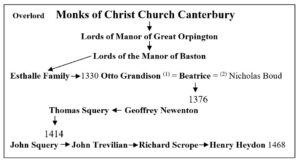More written records are available in the medieval period and they reveal that Hayes developed as a small community. Both churches, manorial and legal records help us to find out about the early village. In 1301 a tax roll provides the names of 26 householders who had sufficient goods to be rated and it is estimated that the population numbered about 140. The wealthiest man was Master John de Bastane who farmed his land and paid manorial dues to his overlord.
The feudal system of landholding meant that most of the land of Hayes was owned by the Monks of Christ Church Canterbury who established the Manor of Great Orpington with its subsidiary manors of Baston and Pickhurst. Baston Manor stood at the top of the steep scarp of the Blackheath beds overlooking the ‘Coney Hill’ Valley. It was isolated from the rest of the settlement and was probably originally a defensive position commanding a fine view to the west. Its owners managed the majority of the land in Hayes and by 1477 there were 17 tenants.

The Manor of Baston passed from the Esthalle family of the Cray Valley to Otto Grandison, a valued friend and companion of King Edward I. After his widow Beatrice’s death the property was in the hands of Geoffrey Newenton who also owned Wickham Manor and he sold to another local family the Squerys. At the end of the medieval period, it was owned by Henry Heydon, a wealthy nobleman and lawyer with several large estates in Norfolk, including Baconsthorpe Castle. His wife Ann was the great aunt of Ann Boleyn, Henry VIII’s second wife. He lived for part of the year at Wickham Court, which he also owned.
Pickhurst Manor in the north of the Parish had fewer tenants and in the early medieval period both Holy Trinity Priory, founded by Queen Matilda in 1141, and the Abbot of Holy Saviour, Bermondsey, in the 13th century, also owned some land in the north of Hayes for which tenants paid dues. The owners of Baston and Pickhurst Manor did not necessarily live in Hayes but relied on tenants to provide them with an income.
The manorial courts record village activities, the appointment of the ale-taster, the settlement of disputes, and in 1450 provide the names of nine husbandmen pardoned by the king – William Robert, John Hever, Richard Shot, Richard Aleyn, Alan Nashe, John Aleyn, Hugh Kechyll, William Frenshe and Simon Kechyll who had taken part in Cade’s rebellion.
The villagers were affected by some of the major changes of that time but chiefly by the Black Death in 1349, which seems to have reduced the population by half. Slowly the population recovered. By 1485 more land in Hayes had been cleared. A few houses had appeared along the track to Bromley and there were small groups clustered around Pickhurst Green, the edge of Baston Hethe and near the Church, which was situated midway between the manors of Baston and Pickhurst.
The church was an important focus in the village. Gifts were left to it and brasses survive to two ministers in the late medieval period John Osteler (died 1461) and Sir John Andrew (minister 1462-1479).
References:
- A descriptive catalogue of ancient deed in the Public Records Office, Vol 1, Vol V1 PRO 1894
- Bernard Davis, Notebooks Vols 1 -10, Bromley Historic Collections
- Charles North, Calendar of Kentish Wills: 1384 to 1559, 1890
- R A L Smith, Canterbury Cathedral Priory, 1943
- Orpington Court Rolls, Canterbury Cathedral Archives,
- John Thorpe, Registrum Roffense, 1798
- Rochester Priory Records, Centre for Kentish Studies
- Lewis Duncan Leland, Testamenta Cantiana, KAS 1906

